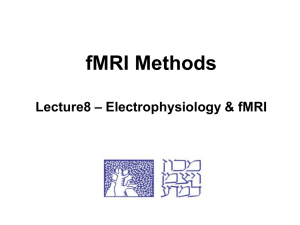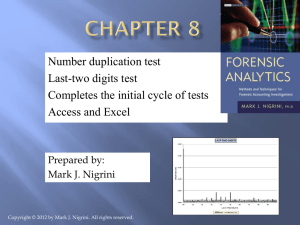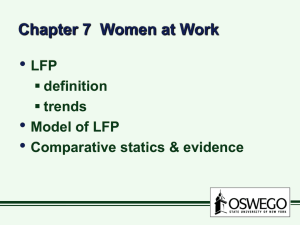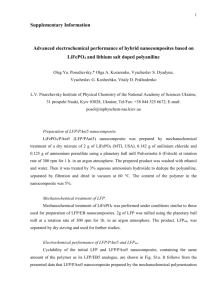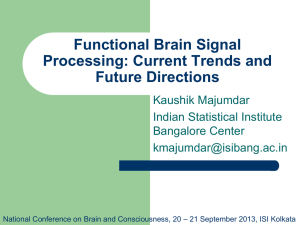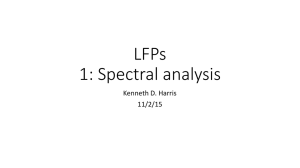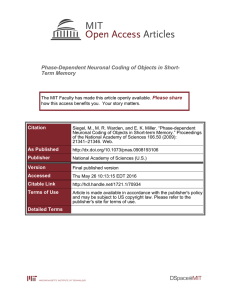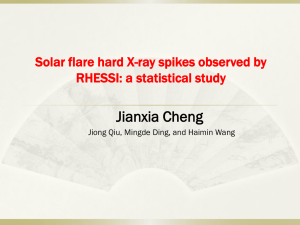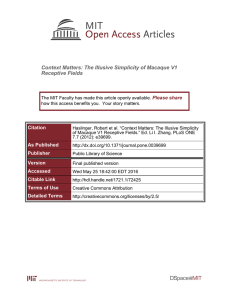Local Field Potentials, Spikes and Modeling Strategies for Both
advertisement
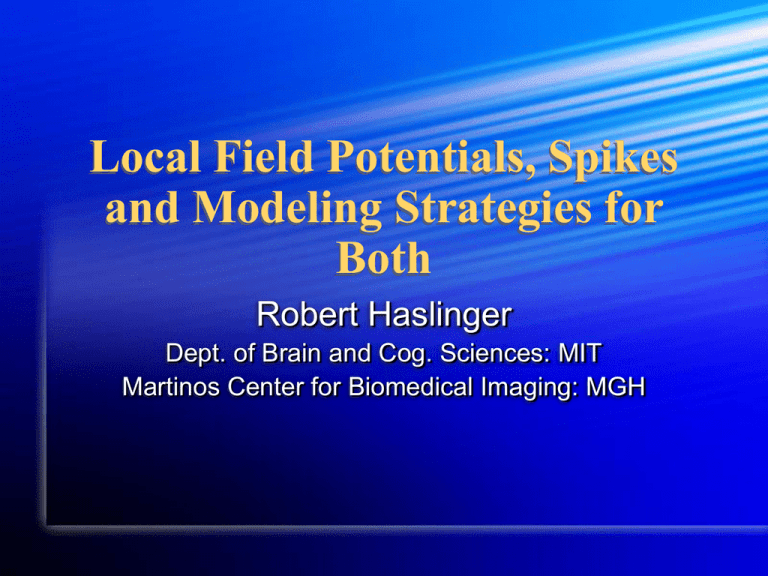
Local Field Potentials, Spikes
and Modeling Strategies for
Both
Robert Haslinger
Dept. of Brain and Cog. Sciences: MIT
Martinos Center for Biomedical Imaging: MGH
Outline
1.
2.
3.
4.
Extra-cellular electric potentials, their
origin, and their filtering
Local Field Potential and Continuous
Models
Spikes and Generalized Linear Models
Example of GLM modeling in rat barrel
cortex
The Brain is a Complex
Structured Network of Neurons
Neural Activity
Neurons have a ~ - 70 mV potential gradient across their membranes
Synaptic activity can depolarize the membrane
Enough depolarization leads to a sharp (1msec 80 mV) change in
potential (spike) which propagates down axons to other neurons
synapses, leak currents, capacitive currents, spikes etc. all move charge
across the neural membrane: GENERATE ELECTRIC POTENTIAL
What do we actually measure ?
What do we actually measure ?
Experiments record
extra-cellular voltage
changes
Voltage changes
generated by
movement of charge
(Na, K, Ca, Cl) across
neuronal membranes
What do we actually measure ?
Experiments record
extra-cellular voltage
changes
Voltage changes
generated by
movement of charge
(Na, K, Ca, Cl) across
neuronal membranes
Generally extra-cellular
voltage is filtered into
two types of signals:
spikes and LFP
Local Field Potential
Local Field Potential (LFP)
Low pass filtered (0.1 250 Hz) signal
“slower” processes,
synapses, leak
currents, capacitive
currents etc.
Haslinger & Neuenschwander
Local Field Potential (LFP)
Low pass filtered (0.1 250 Hz) signal
“slower” processes,
synapses, leak
currents, capacitive
currents etc.
Haslinger & Devor
Local Field Potential
LFP generated through
current “sinks” and
“sources”
Local Field Potential
LFP generated through
current “sinks” and
“sources”
Local Field Potential
LFP generated through
current “sinks” and
“sources”
Local Field Potential
LFP generated through
current “sinks” and
“sources”
Local Field Potential
LFP generated through
current “sinks” and
“sources”
Can think of charge
imbalances creating
extracellular voltage
Local Field Potential
LFP generated through
current “sinks” and
“sources”
Can think of charge
imbalances creating
extracellular voltage
Or can think in terms of
voltage drops due to
current loops , e.g.
Ohm’s Law (V=IR)
current
loop
LFP results from the superposition of
potentials from ALL sinks and sources
We only see sinks and
source pairs that don’t
overlap with each other, or
with sinks and sources from
other neurons.
Elongated pyramidal
neurons, YES.
Compact interneurons or
layer IV stellate cells : NO
Synchronous (across cells)
events: YES
Sinks not always excitatory,
sources not always inhibitory
LFP Changes With Position
LFP Is Not Well Localized
Spatially
LFP localized within .5 3 mm (at best)
V~1/r … but in cortex its
worse !!!!
Caused by dendritic
and cortical geometry
Pseudo 1D Geometry
Cortex is a thin (2-3 mm thick) sheet
Greatest anatomical variation perpendicular to the
sheet
Essentially a ONE DIMENSIONAL geometry
In 1D , V ~ z , not 1/r
LFP is Non-Local
LFP is Non-Local
LFP is Non-Local
Characterizing LFP
Highly complex continuous time signal
Intuition about phenomena at different
time scales
Can apply all sorts of signal processing
techniques
Helps to have some idea of what you’re
looking for
Signal Processing Techniques
Fourier and Windowed Fourier Transform (multitaper) (Chronux)
Wavelets and Multi-Resolution Analysis
Time - Frequency representation
Hilbert Transform
Power, Phase
Empirical Mode Decomposition
Autoregressive Modeling
Coherency Analysis (Chronux)
Granger Causality
Information Theory
Frequency - ology
Alpha (8-12 Hz) attention
Beta (12-20 Hz)
Gamma (40-80 Hz) complex
processing, mediated by inhibition
Delta (1-4 Hz) slow wave sleep
Mu (8-12 Hz) but in motor cortex
Theta (4-8 Hz) Hippocampus
Statistical Modeling of LFP
p(neural activity | covariates)
covariates
EEG, LFP
System
Linear Regression
(Gaussian Model of Variability)
Y X
Many standard methods for regression, model
selection, goodness of fit and so forth
Spikes
Spikes : “high pass filtered”
Extra-cellular voltage is high pass filtered and
discrete spikes are identified through spike sorting
Neurons generating spikes
are located near the
electrode
See spikes from all types of
neurons (pyramids,
interneurons etc.)
Functional distinctions
based on spike shape (FS =
inhibitory, RS = excitatory)
Spikes are discrete events
Smooth into spike rate - continuous process
Interspike interval distribution (ISI)
Spectral techniques (multi-taper)
Spikes are discrete events
Smooth into spike rate - continuous process
Interspike interval distribution (ISI)
Spectral techniques (multi-taper)
Point Process Statistical Modeling
Introducing Generalized Linear Models
p(neural activity | covariates)
covariates
EEG, LFP
System
Linear Regression
(Gaussian Model of Variability)
covariates
Y X
spikes
System
Conditional Intensity Function
Spikes depend upon both external covariates (stimuli)
and the previous history of the spiking process
(t) = ( x(t) | Ht )
(t) dt is the probability of a spike conditioned on the
past spiking history Ht and a function of the external
covariates (stimuli) x(t)
Conditional Intensity Function
Spikes depend upon both external covariates (stimuli)
and the previous history of the spiking process
(t) = ( x(t) | Ht )
(t) dt is the probability of a spike conditioned on the
past spiking history Ht and a function of the external
covariates (stimuli) x(t)
Our goal in statistical modeling is to get (t). Once we
know that, we know “everything” (probability of any
spike sequence for example)
Regression for Event-Like Data
“Standard” regression (linear or non-linear)
assumes continuous data and Gaussian
noise
Spikes are localized events, we should
respect the nature of the data
A statistical model can be used for inference,
prediction, decoding and simulation
There are standard techniques for modeling
point process data, e.g. logistic regression
and other Generalized Linear Models
Linear vs. Logistic Regression
(t) = ii xi(t)
restricted only
by range of {xi}
Linear vs. Logistic Regression
(t) = ii xi(t)
restricted only
by range of {xi}
log[ (t) / (1 - (t) ] = ii xi(t)
is restricted between 0 and 1
is a PROBABILITY
Linear vs. Logistic Regression
(t) = ii xi(t)
restricted only
by range of {xi}
LINK FUNCTION
log[ (t) / (1 - (t) ] = ii xi(t)
is restricted between 0 and 1
is a PROBABILITY
Generalized Linear Models
Logistic regression is one example of a
Generalized Linear Model (GLM)
Can be solved by maximum likelihood
estimation (log-concave problem)
There exist efficient estimation techniques
(iterative re-weighted least squares)
They can be solved in Matlab (glmfit.m) and
almost all statistical packages
Possible Covariates to Include
log[ (t) / (1 - (t)) ] = ii fi (stimulus)
Possible Covariates to Include
log[ (t) / (1 - (t)) ] = ii fi (stimulus)
jj gj (spiking history)
Possible Covariates to Include
log[ (t) / (1 - (t)) ] = ii fi (stimulus)
jj gj (spiking history)
kk hk (ensemble spiking)
Possible Covariates to Include
log[ (t) / (1 - (t)) ] = ii fi (stimulus)
jj gj (spiking history)
kk hk (ensemble spiking)
pp rp (LFP)
Possible Covariates to Include
log[ (t) / (1 - (t)) ] = ii fi (stimulus)
jj gj (spiking history)
kk hk (ensemble spiking)
pp rp (LFP)
Fitted parameters give the importance of
different contributions
Goodness-of-Fit
ti1
zi (u | Hu )du
ti
t1 , t2 ...tn
Time
Rescale
z1 , z2 ...zn
Kolmogorov-Smirnov (KS) Plot:
ECDF(zi)
Time-Rescaling Theorem: zi’s are i.i.d. exponential rate 1
CDF(exp(1))
GLM Example :
Rat Barrel Cortex
M. Andermann
Inclusion of Different Covariates
Inclusion of Different Covariates
Time since stimulus
ii Bi (t)
spline basis
functions
Inclusion of Different Covariates
Time since stimulus
ii Bi (t)
spline basis
functions
Deflection Angle
cos (0) =
1 cos() - 2 sin()
Inclusion of Different Covariates
Time since stimulus
ii Bi (t)
spline basis
functions
Deflection Angle
cos (0) =
1 cos() - 2 sin()
Spike History
jj gj ( t - tj )
g(t) = 0 (no spike at t)
= 1 (spike at t)
FINAL
MODEL
log[ (t) / (1 - (t) ) ] = ii Bi (t)
+ 1 cos() - 2 sin()
jj gj ( t - tj )
FINAL
MODEL
log[ (t) / (1 - (t) ) ] = ii Bi (t)
+ 1 cos() - 2 sin()
jj gj ( t - tj )
Often spike history effects account for most of
the statistics !!!!!!!
History Term
FINAL
MODEL
log[ (t) / (1 - (t) ) ] = ii Bi (t)
+ 1 cos() - 2 sin()
jj gj ( t - tj )
Often spike history effects account for most of
the statistics !!!!!!!
History Term
bursting
refractory
Conclusions
Important to understand the physical origins of what we record
and model
LFP and Spikes are fundamentally different types of data and
require different modeling strategies
LFP requires some thought about what to model, but techniques
are standard
Spikes effectively described by probability but are point
processes and require different techniques
Logistic Regression (and other GLMs) for spikes. Kolmogorov
Smirnov test for goodness of fit
Rigorous model identification is important to determine the
importance of different covariates.
This can be a prelude to developing more effective BMIs
